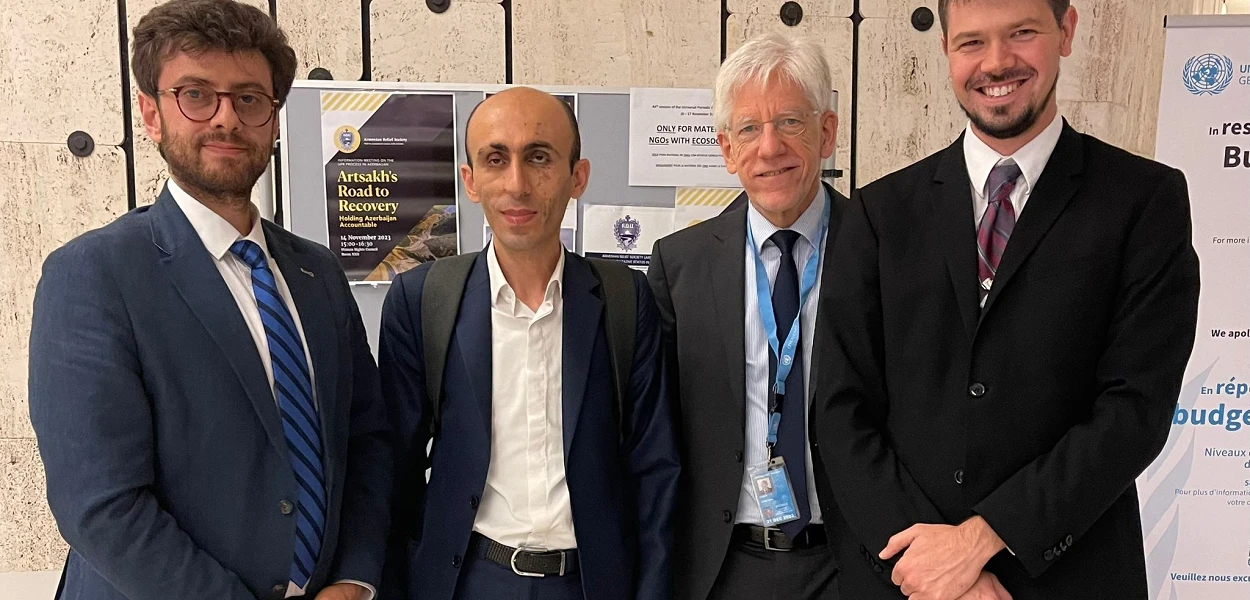
At UN, young Armenian leader recounts ethnic cleansing of Nagorno Karabakh
A month and a half after the dictatorship of Azerbaijan ethnically cleansed the ancient Armenian Christian community of Nagorno Karabakh, Artak Beglaryan, a well-known human rights activist from the region, appeared at the UN in Geneva on November 14 to share his testimony of what happened during Azerbaijan’s attack.

The side event, hosted by the Armenian Relief Society, was entitled “Artsakh’s Road to Recovery.” It was planned to coincide with the UN Human Rights Council’s Universal Periodic Review of Azerbaijan’s human rights record. Outside agitators, likely affiliated with the Azerbaijani Mission in Geneva, tried repeatedly to disrupt the event, but it went forward without incident.
A life of tragedy and perseverance
Artak Beglaryan was born in Nagorno Karabakh in 1988, just as the First Karabakh War was beginning. When Beglaryan was four, his father was killed while fighting for Nagorno Karabakh’s freedom. When he was six, he was blinded when a landmine exploded near his family’s home. But Beglaryan never allowed this tragedy to hold him back. He went on to study on three continents and to serve as both the State Minister of the Republic of Artsakh (Nagorno Karabakh) and as the Republic of Artsakh’s Human Rights Ombudsman.
He was in this role when Azerbaijan launched its new war against Nagorno Karabakh in 2020. Beglaryan and his staff relentlessly and dispassionately documented the numerous atrocities Azerbaijan carried out in this war, and Beglaryan soon became the public face of the Armenian people of Karabakh as they faced a new round of genocide.
Siege and forced flight
At the side event, Beglaryan described the circumstances that forced nearly the entire Armenian population of Nagorno Karabakh to flee to Armenia in late September this year. At least 230 Armenians were killed in Azerbaijan’s initial assault, including 19 civilians and six children.
“We have also documented, with photos, at least 14 cases of torture and mutilation,” Beglaryan said, “including Azerbaijani soldiers cutting off the ears of dead Armenian soldiers. The true number is surely higher.”
Nagorno Karabakh’s Defense Forces were overwhelmed by the attack, and major fighting ended after two days. But for four days after the ceasefire, Beglaryan noted, Azerbaijan kept the electricity and communications down in Nagorno Karabakh. Thousands of displaced people huddled in basements and churches, with little medicine or fuel available after Azerbaijan’s nine-month blockade of the territory.
The towns of Martuni and Martakert were completely under siege by Azerbaijani forces, with no access or communication to the outside world. Beglaryan’s uncle had a stroke from the stress of not being able to contact his son, who was serving in the Defense Forces.
“They were creating a coercive environment to pressure us to leave, with genocidal intent,” Beglaryan concluded.
When the Armenians were eventually allowed to leave, the road between Karabakh and Armenia was flooded with overcrowded cars as people sought to escape the Azerbaijani takeover. What is normally a journey of two hours took between 30 and 50 hours, Beglaryan said. At least 64 people died during the evacuation, due to health crises and car accidents on the road. Beglaryan said that, today, fewer than 25 Armenians are left in Nagorno Karabakh.
In the aftermath of the attack, Beglaryan was aware that Azerbaijani forces were seeking to abduct him, as they eventually kidnapped eight current and former members of Nagorno Karabakh’s elected government, and at least one civilian. “But my brothers were able to get me through the checkpoint safely,” he said.
“The hardest part was saying farewell to the graves of my mother and my father,” Beglaryan said. “My father died fighting for his family to be able to live in freedom and dignity. My mother raised me to believe in collective responsibility. I felt guilty, leaving them behind.”
Ocampo: evidence of genocide
Also appearing at the event were Professor Luis Ocampo, the first prosecutor of the International Criminal Court, Professor Irene Massimino of the Lemkin Institute for Genocide Prevention, and Dr. Ani Ghazaryan Drissi of the World Council of Churches.
In his remarks, Ocampo argued that the ethnic cleansing of Nagorno Karabakh met the legal definition of genocide. He pointed to “the fact that 100,000 people felt so threatened that they left everything behind, in terrible conditions, to try to get to safety.” For Ocampo, this was evidence that clause 2b of the 1948 Genocide Convention had been met: destroying “a national, ethnical, racial or religious group” by “causing serious bodily or mental harm to members of the group.”
Disruption and intimidation
Before and during the event, unknown individuals used various means to try to disrupt it. At the UN headquarters, the posters for the event were repeatedly torn down and stolen. One eyewitness told Beglaryan that they witnessed the Azerbaijani ambassador in Geneva personally tearing down the posters.
Other individuals surreptitiously took photos of Beglaryan meeting with CSI staff, and circulated them on pro-Azerbaijani Telegram channels. The photos were accompanied by insulting and intimidating language. “What’s he doing there?” read one. “And most importantly, how did you get out?”
Another message said, “The organizers of this propaganda tour should remember how Artak’s previous actions ended – waiting for arrest in Khankendi [Azerbaijan’s name for the capital of Nagorno Karabakh].”
In addition to hosting the side event, the Armenian Legal Center and several other organizations submitted stakeholder reports to the Human Rights Council about the ethnic cleansing of Nagorno Karabakh.
Beglaryan concluded his remarks at the event by affirming, “Our people want to return to their land. They will do so if they have international guarantees for their safety and their dignity.”





